Introduction to Management
VerifiedAdded on 2023/04/21
|11
|2296
|235
AI Summary
This document provides an introduction to management, focusing on Apple Inc. as a case study. It covers topics such as customer base, mission and core values, vision, corporate level strategies, business level strategies, and a SWOT analysis of Apple Inc.
Contribute Materials
Your contribution can guide someone’s learning journey. Share your
documents today.
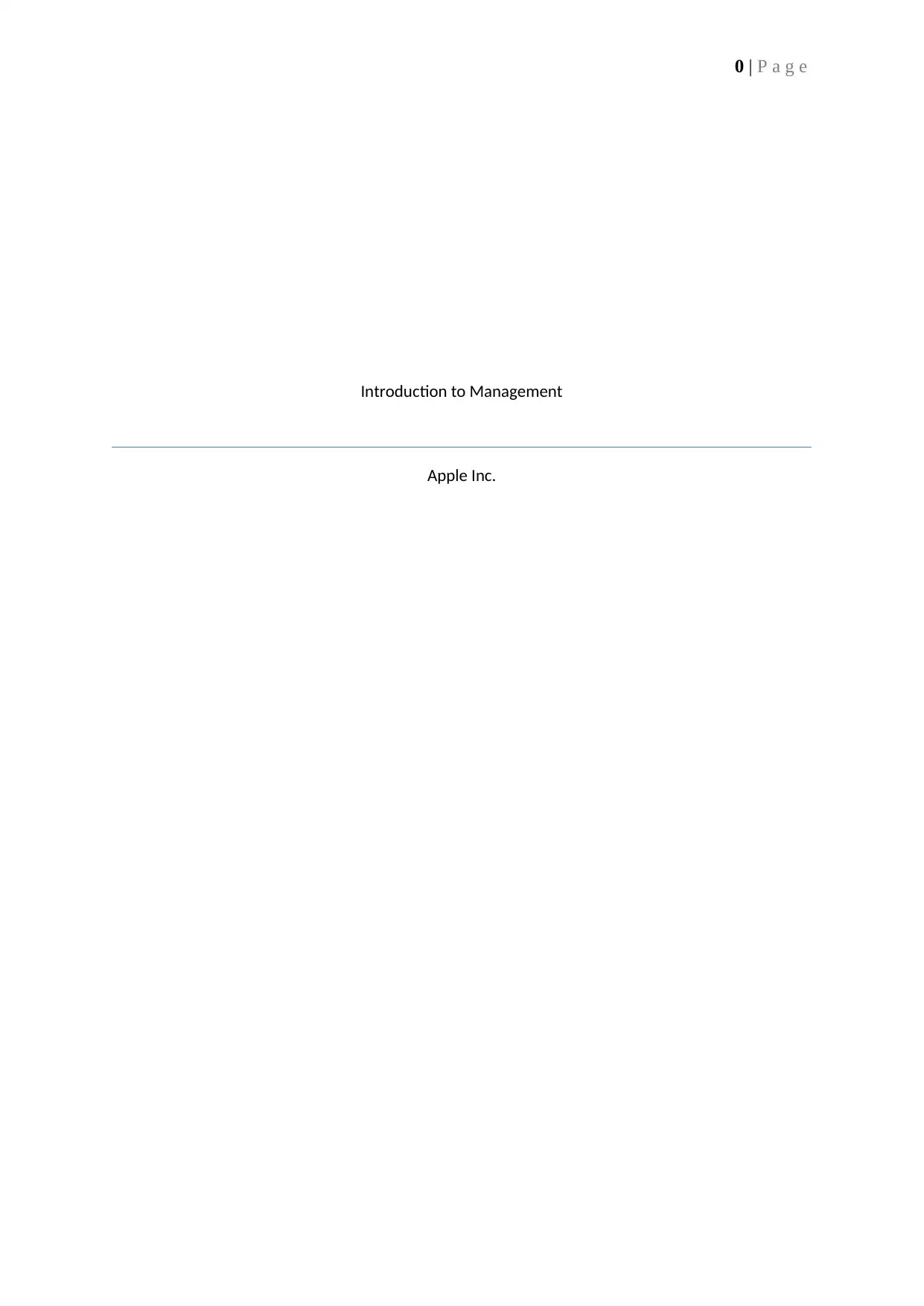
0 | P a g e
Introduction to Management
Apple Inc.
Introduction to Management
Apple Inc.
Secure Best Marks with AI Grader
Need help grading? Try our AI Grader for instant feedback on your assignments.
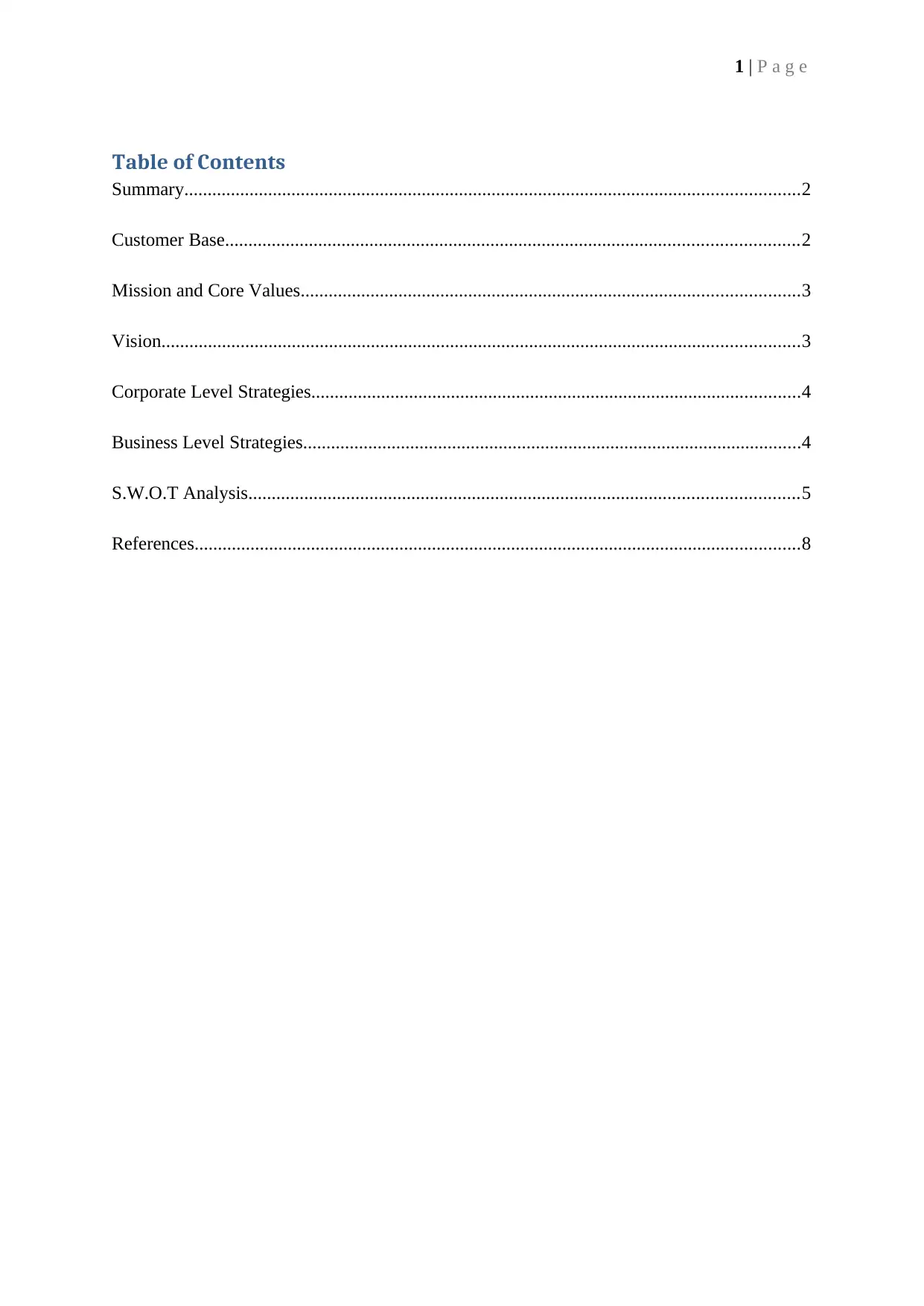
1 | P a g e
Table of Contents
Summary....................................................................................................................................2
Customer Base...........................................................................................................................2
Mission and Core Values...........................................................................................................3
Vision.........................................................................................................................................3
Corporate Level Strategies.........................................................................................................4
Business Level Strategies...........................................................................................................4
S.W.O.T Analysis......................................................................................................................5
References..................................................................................................................................8
Table of Contents
Summary....................................................................................................................................2
Customer Base...........................................................................................................................2
Mission and Core Values...........................................................................................................3
Vision.........................................................................................................................................3
Corporate Level Strategies.........................................................................................................4
Business Level Strategies...........................................................................................................4
S.W.O.T Analysis......................................................................................................................5
References..................................................................................................................................8
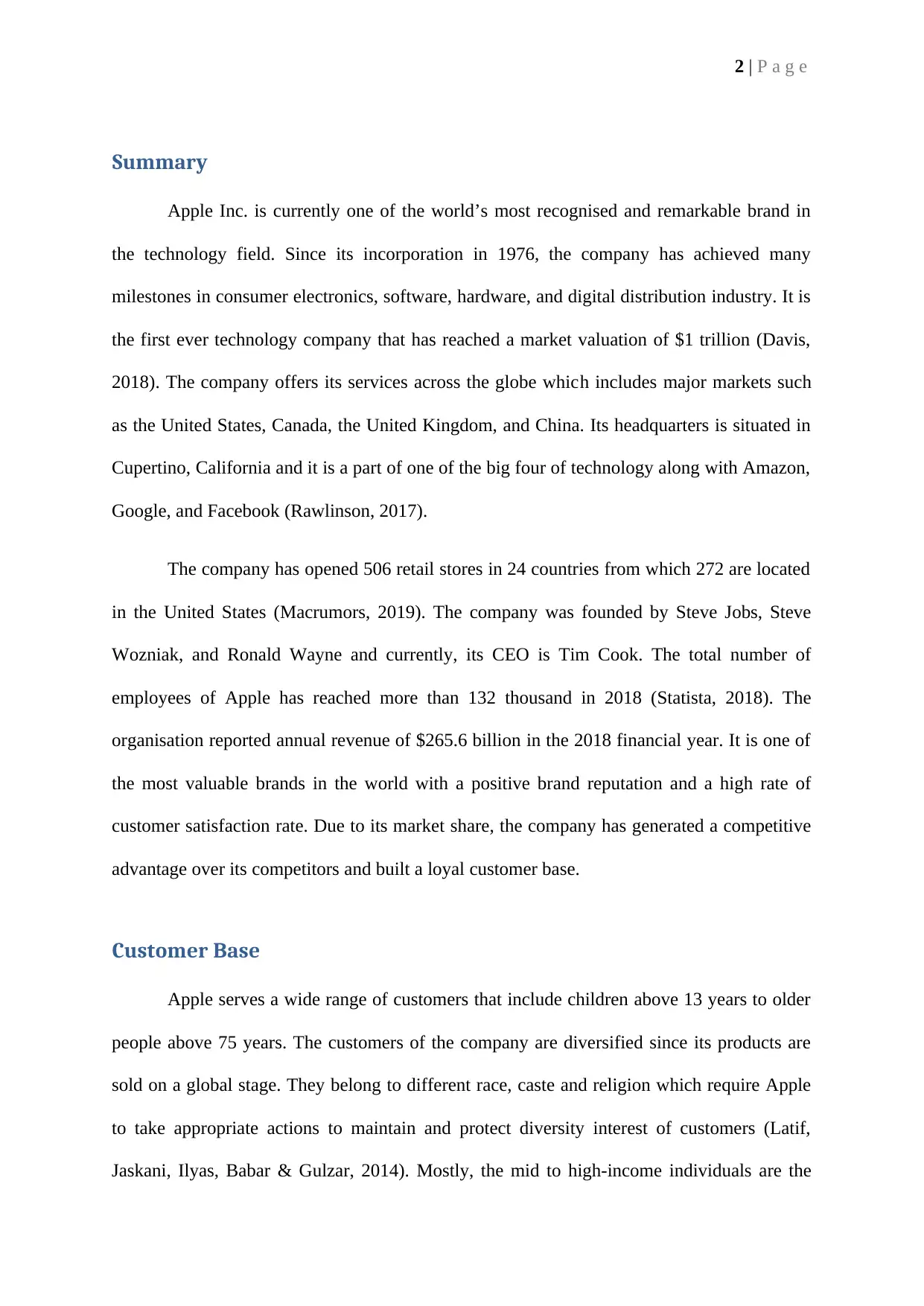
2 | P a g e
Summary
Apple Inc. is currently one of the world’s most recognised and remarkable brand in
the technology field. Since its incorporation in 1976, the company has achieved many
milestones in consumer electronics, software, hardware, and digital distribution industry. It is
the first ever technology company that has reached a market valuation of $1 trillion (Davis,
2018). The company offers its services across the globe which includes major markets such
as the United States, Canada, the United Kingdom, and China. Its headquarters is situated in
Cupertino, California and it is a part of one of the big four of technology along with Amazon,
Google, and Facebook (Rawlinson, 2017).
The company has opened 506 retail stores in 24 countries from which 272 are located
in the United States (Macrumors, 2019). The company was founded by Steve Jobs, Steve
Wozniak, and Ronald Wayne and currently, its CEO is Tim Cook. The total number of
employees of Apple has reached more than 132 thousand in 2018 (Statista, 2018). The
organisation reported annual revenue of $265.6 billion in the 2018 financial year. It is one of
the most valuable brands in the world with a positive brand reputation and a high rate of
customer satisfaction rate. Due to its market share, the company has generated a competitive
advantage over its competitors and built a loyal customer base.
Customer Base
Apple serves a wide range of customers that include children above 13 years to older
people above 75 years. The customers of the company are diversified since its products are
sold on a global stage. They belong to different race, caste and religion which require Apple
to take appropriate actions to maintain and protect diversity interest of customers (Latif,
Jaskani, Ilyas, Babar & Gulzar, 2014). Mostly, the mid to high-income individuals are the
Summary
Apple Inc. is currently one of the world’s most recognised and remarkable brand in
the technology field. Since its incorporation in 1976, the company has achieved many
milestones in consumer electronics, software, hardware, and digital distribution industry. It is
the first ever technology company that has reached a market valuation of $1 trillion (Davis,
2018). The company offers its services across the globe which includes major markets such
as the United States, Canada, the United Kingdom, and China. Its headquarters is situated in
Cupertino, California and it is a part of one of the big four of technology along with Amazon,
Google, and Facebook (Rawlinson, 2017).
The company has opened 506 retail stores in 24 countries from which 272 are located
in the United States (Macrumors, 2019). The company was founded by Steve Jobs, Steve
Wozniak, and Ronald Wayne and currently, its CEO is Tim Cook. The total number of
employees of Apple has reached more than 132 thousand in 2018 (Statista, 2018). The
organisation reported annual revenue of $265.6 billion in the 2018 financial year. It is one of
the most valuable brands in the world with a positive brand reputation and a high rate of
customer satisfaction rate. Due to its market share, the company has generated a competitive
advantage over its competitors and built a loyal customer base.
Customer Base
Apple serves a wide range of customers that include children above 13 years to older
people above 75 years. The customers of the company are diversified since its products are
sold on a global stage. They belong to different race, caste and religion which require Apple
to take appropriate actions to maintain and protect diversity interest of customers (Latif,
Jaskani, Ilyas, Babar & Gulzar, 2014). Mostly, the mid to high-income individuals are the
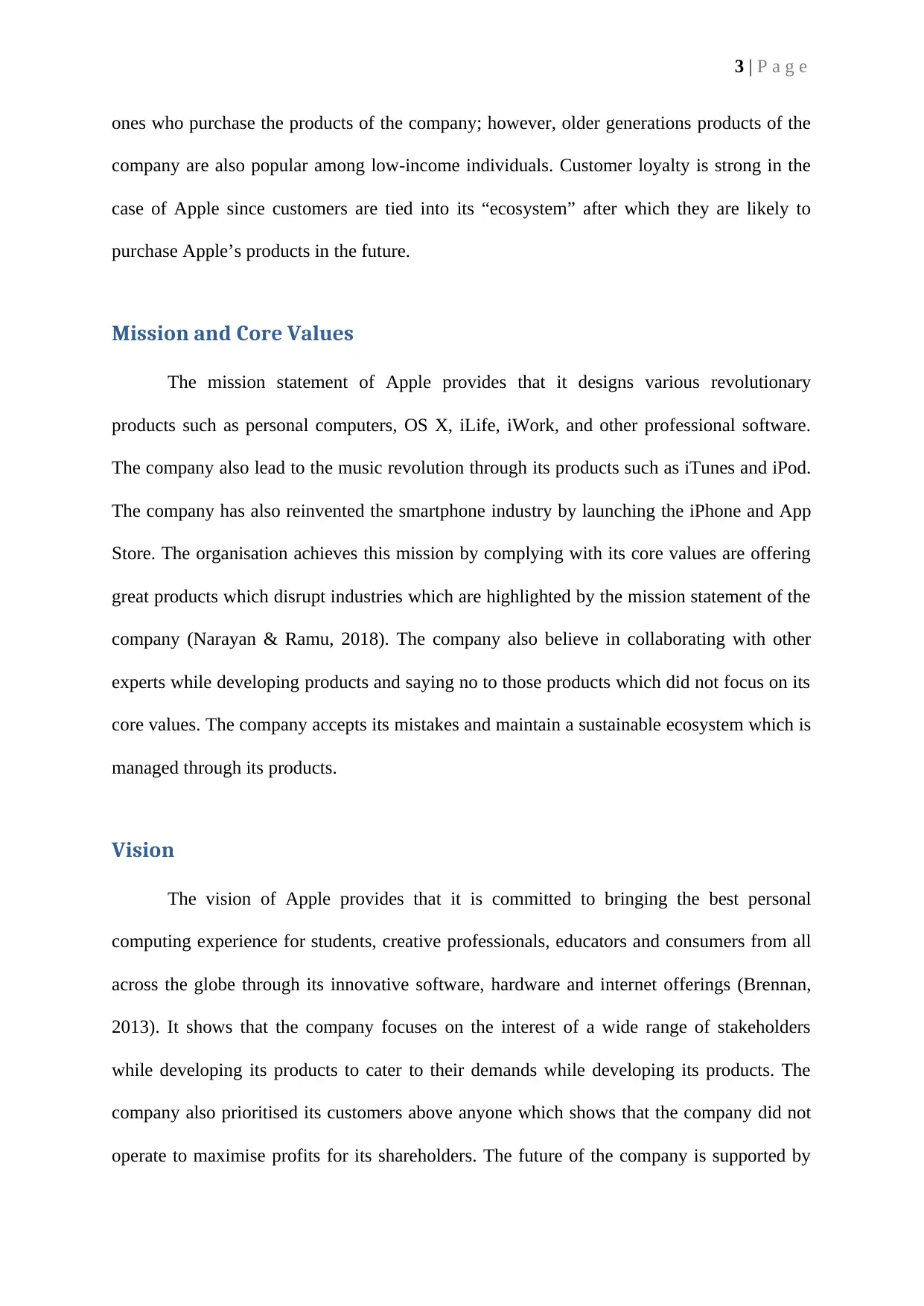
3 | P a g e
ones who purchase the products of the company; however, older generations products of the
company are also popular among low-income individuals. Customer loyalty is strong in the
case of Apple since customers are tied into its “ecosystem” after which they are likely to
purchase Apple’s products in the future.
Mission and Core Values
The mission statement of Apple provides that it designs various revolutionary
products such as personal computers, OS X, iLife, iWork, and other professional software.
The company also lead to the music revolution through its products such as iTunes and iPod.
The company has also reinvented the smartphone industry by launching the iPhone and App
Store. The organisation achieves this mission by complying with its core values are offering
great products which disrupt industries which are highlighted by the mission statement of the
company (Narayan & Ramu, 2018). The company also believe in collaborating with other
experts while developing products and saying no to those products which did not focus on its
core values. The company accepts its mistakes and maintain a sustainable ecosystem which is
managed through its products.
Vision
The vision of Apple provides that it is committed to bringing the best personal
computing experience for students, creative professionals, educators and consumers from all
across the globe through its innovative software, hardware and internet offerings (Brennan,
2013). It shows that the company focuses on the interest of a wide range of stakeholders
while developing its products to cater to their demands while developing its products. The
company also prioritised its customers above anyone which shows that the company did not
operate to maximise profits for its shareholders. The future of the company is supported by
ones who purchase the products of the company; however, older generations products of the
company are also popular among low-income individuals. Customer loyalty is strong in the
case of Apple since customers are tied into its “ecosystem” after which they are likely to
purchase Apple’s products in the future.
Mission and Core Values
The mission statement of Apple provides that it designs various revolutionary
products such as personal computers, OS X, iLife, iWork, and other professional software.
The company also lead to the music revolution through its products such as iTunes and iPod.
The company has also reinvented the smartphone industry by launching the iPhone and App
Store. The organisation achieves this mission by complying with its core values are offering
great products which disrupt industries which are highlighted by the mission statement of the
company (Narayan & Ramu, 2018). The company also believe in collaborating with other
experts while developing products and saying no to those products which did not focus on its
core values. The company accepts its mistakes and maintain a sustainable ecosystem which is
managed through its products.
Vision
The vision of Apple provides that it is committed to bringing the best personal
computing experience for students, creative professionals, educators and consumers from all
across the globe through its innovative software, hardware and internet offerings (Brennan,
2013). It shows that the company focuses on the interest of a wide range of stakeholders
while developing its products to cater to their demands while developing its products. The
company also prioritised its customers above anyone which shows that the company did not
operate to maximise profits for its shareholders. The future of the company is supported by
Secure Best Marks with AI Grader
Need help grading? Try our AI Grader for instant feedback on your assignments.
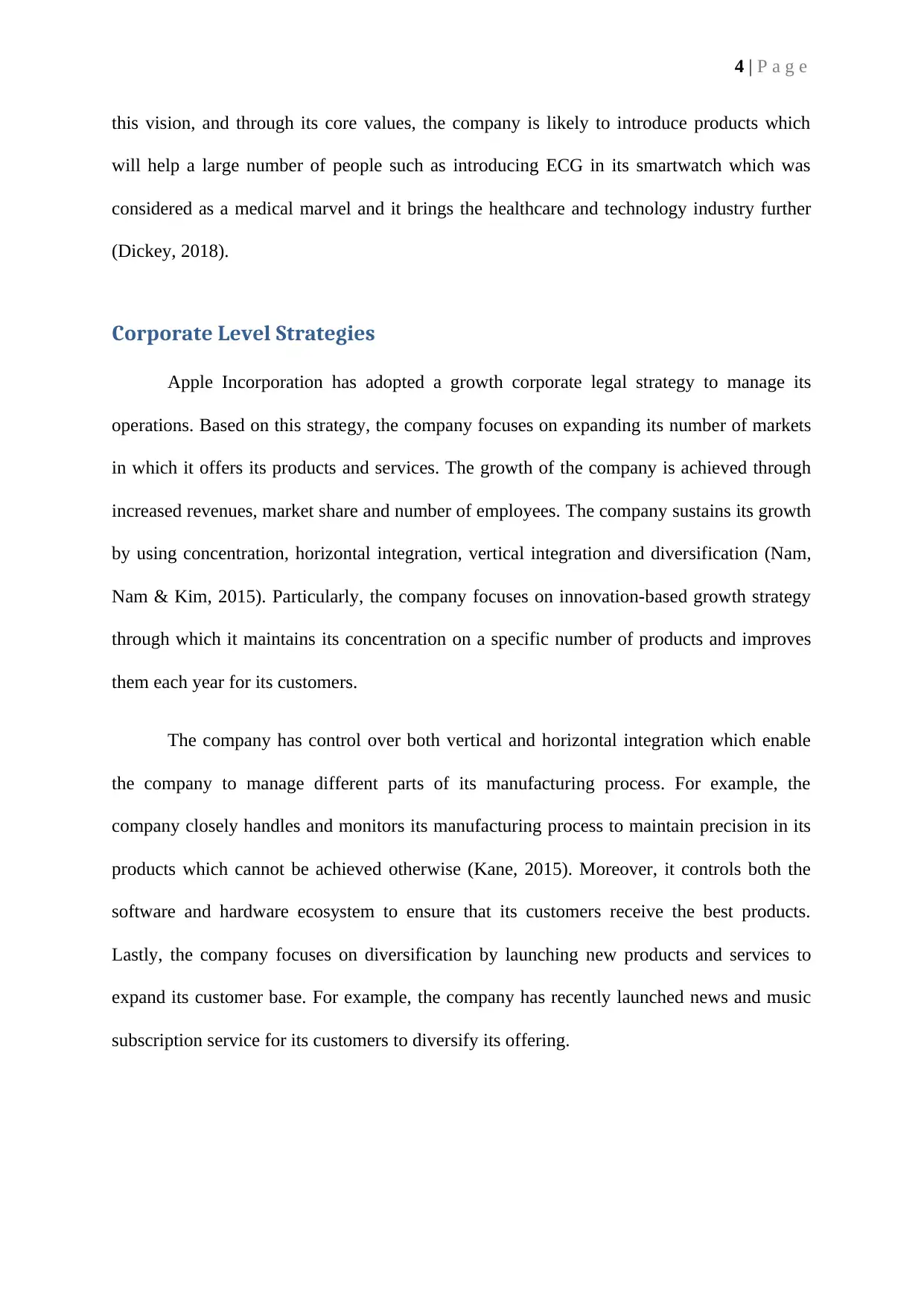
4 | P a g e
this vision, and through its core values, the company is likely to introduce products which
will help a large number of people such as introducing ECG in its smartwatch which was
considered as a medical marvel and it brings the healthcare and technology industry further
(Dickey, 2018).
Corporate Level Strategies
Apple Incorporation has adopted a growth corporate legal strategy to manage its
operations. Based on this strategy, the company focuses on expanding its number of markets
in which it offers its products and services. The growth of the company is achieved through
increased revenues, market share and number of employees. The company sustains its growth
by using concentration, horizontal integration, vertical integration and diversification (Nam,
Nam & Kim, 2015). Particularly, the company focuses on innovation-based growth strategy
through which it maintains its concentration on a specific number of products and improves
them each year for its customers.
The company has control over both vertical and horizontal integration which enable
the company to manage different parts of its manufacturing process. For example, the
company closely handles and monitors its manufacturing process to maintain precision in its
products which cannot be achieved otherwise (Kane, 2015). Moreover, it controls both the
software and hardware ecosystem to ensure that its customers receive the best products.
Lastly, the company focuses on diversification by launching new products and services to
expand its customer base. For example, the company has recently launched news and music
subscription service for its customers to diversify its offering.
this vision, and through its core values, the company is likely to introduce products which
will help a large number of people such as introducing ECG in its smartwatch which was
considered as a medical marvel and it brings the healthcare and technology industry further
(Dickey, 2018).
Corporate Level Strategies
Apple Incorporation has adopted a growth corporate legal strategy to manage its
operations. Based on this strategy, the company focuses on expanding its number of markets
in which it offers its products and services. The growth of the company is achieved through
increased revenues, market share and number of employees. The company sustains its growth
by using concentration, horizontal integration, vertical integration and diversification (Nam,
Nam & Kim, 2015). Particularly, the company focuses on innovation-based growth strategy
through which it maintains its concentration on a specific number of products and improves
them each year for its customers.
The company has control over both vertical and horizontal integration which enable
the company to manage different parts of its manufacturing process. For example, the
company closely handles and monitors its manufacturing process to maintain precision in its
products which cannot be achieved otherwise (Kane, 2015). Moreover, it controls both the
software and hardware ecosystem to ensure that its customers receive the best products.
Lastly, the company focuses on diversification by launching new products and services to
expand its customer base. For example, the company has recently launched news and music
subscription service for its customers to diversify its offering.
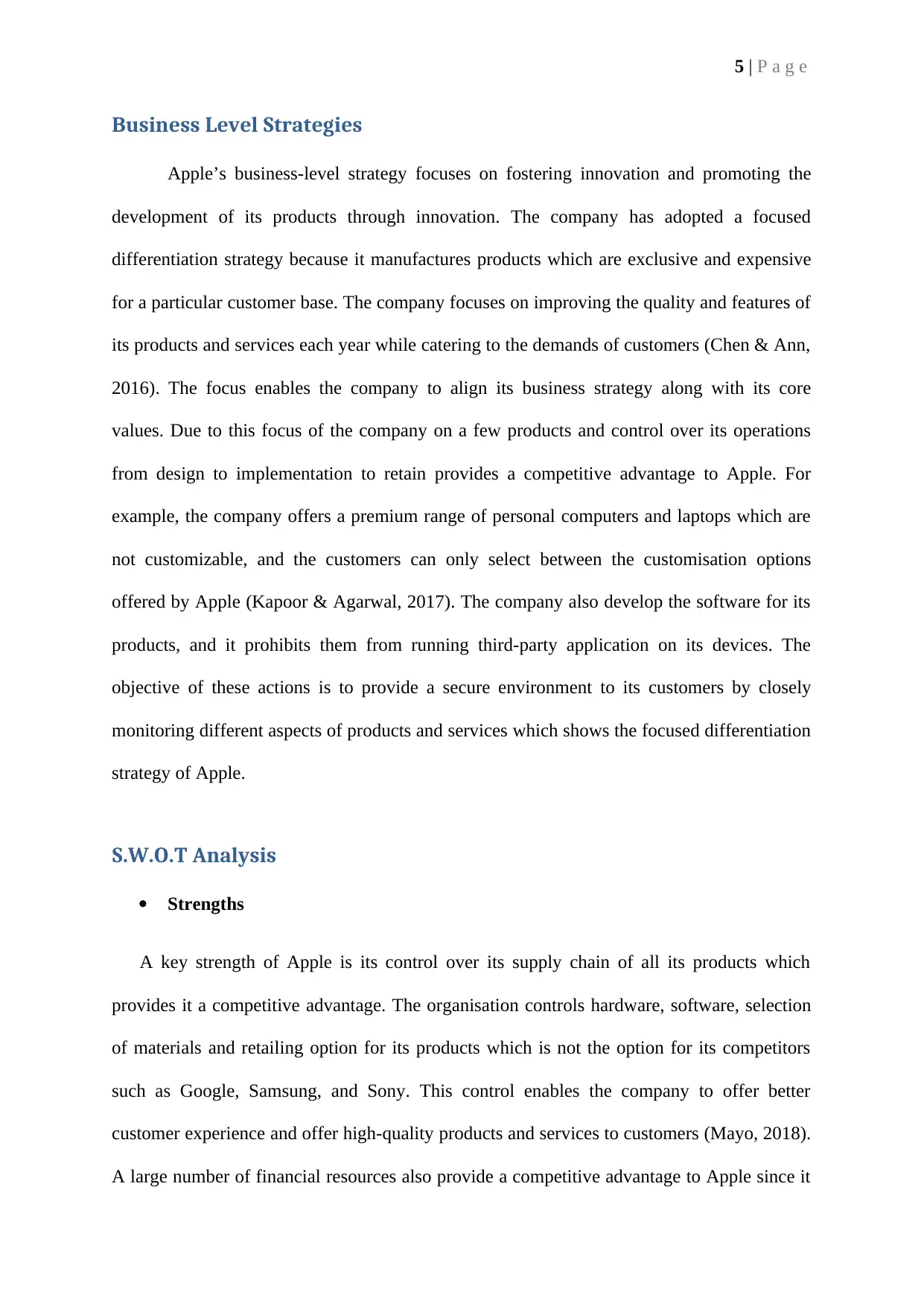
5 | P a g e
Business Level Strategies
Apple’s business-level strategy focuses on fostering innovation and promoting the
development of its products through innovation. The company has adopted a focused
differentiation strategy because it manufactures products which are exclusive and expensive
for a particular customer base. The company focuses on improving the quality and features of
its products and services each year while catering to the demands of customers (Chen & Ann,
2016). The focus enables the company to align its business strategy along with its core
values. Due to this focus of the company on a few products and control over its operations
from design to implementation to retain provides a competitive advantage to Apple. For
example, the company offers a premium range of personal computers and laptops which are
not customizable, and the customers can only select between the customisation options
offered by Apple (Kapoor & Agarwal, 2017). The company also develop the software for its
products, and it prohibits them from running third-party application on its devices. The
objective of these actions is to provide a secure environment to its customers by closely
monitoring different aspects of products and services which shows the focused differentiation
strategy of Apple.
S.W.O.T Analysis
Strengths
A key strength of Apple is its control over its supply chain of all its products which
provides it a competitive advantage. The organisation controls hardware, software, selection
of materials and retailing option for its products which is not the option for its competitors
such as Google, Samsung, and Sony. This control enables the company to offer better
customer experience and offer high-quality products and services to customers (Mayo, 2018).
A large number of financial resources also provide a competitive advantage to Apple since it
Business Level Strategies
Apple’s business-level strategy focuses on fostering innovation and promoting the
development of its products through innovation. The company has adopted a focused
differentiation strategy because it manufactures products which are exclusive and expensive
for a particular customer base. The company focuses on improving the quality and features of
its products and services each year while catering to the demands of customers (Chen & Ann,
2016). The focus enables the company to align its business strategy along with its core
values. Due to this focus of the company on a few products and control over its operations
from design to implementation to retain provides a competitive advantage to Apple. For
example, the company offers a premium range of personal computers and laptops which are
not customizable, and the customers can only select between the customisation options
offered by Apple (Kapoor & Agarwal, 2017). The company also develop the software for its
products, and it prohibits them from running third-party application on its devices. The
objective of these actions is to provide a secure environment to its customers by closely
monitoring different aspects of products and services which shows the focused differentiation
strategy of Apple.
S.W.O.T Analysis
Strengths
A key strength of Apple is its control over its supply chain of all its products which
provides it a competitive advantage. The organisation controls hardware, software, selection
of materials and retailing option for its products which is not the option for its competitors
such as Google, Samsung, and Sony. This control enables the company to offer better
customer experience and offer high-quality products and services to customers (Mayo, 2018).
A large number of financial resources also provide a competitive advantage to Apple since it
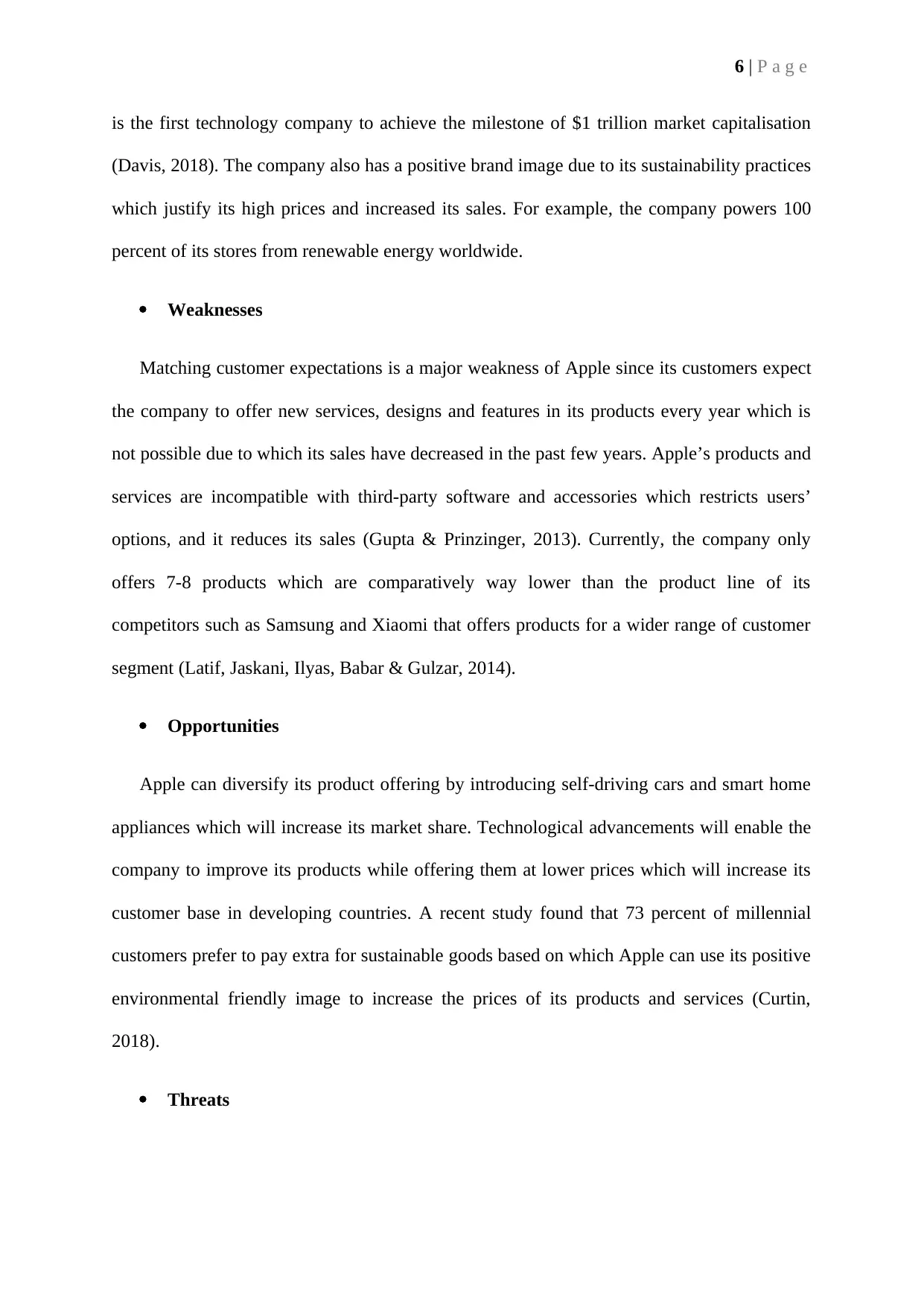
6 | P a g e
is the first technology company to achieve the milestone of $1 trillion market capitalisation
(Davis, 2018). The company also has a positive brand image due to its sustainability practices
which justify its high prices and increased its sales. For example, the company powers 100
percent of its stores from renewable energy worldwide.
Weaknesses
Matching customer expectations is a major weakness of Apple since its customers expect
the company to offer new services, designs and features in its products every year which is
not possible due to which its sales have decreased in the past few years. Apple’s products and
services are incompatible with third-party software and accessories which restricts users’
options, and it reduces its sales (Gupta & Prinzinger, 2013). Currently, the company only
offers 7-8 products which are comparatively way lower than the product line of its
competitors such as Samsung and Xiaomi that offers products for a wider range of customer
segment (Latif, Jaskani, Ilyas, Babar & Gulzar, 2014).
Opportunities
Apple can diversify its product offering by introducing self-driving cars and smart home
appliances which will increase its market share. Technological advancements will enable the
company to improve its products while offering them at lower prices which will increase its
customer base in developing countries. A recent study found that 73 percent of millennial
customers prefer to pay extra for sustainable goods based on which Apple can use its positive
environmental friendly image to increase the prices of its products and services (Curtin,
2018).
Threats
is the first technology company to achieve the milestone of $1 trillion market capitalisation
(Davis, 2018). The company also has a positive brand image due to its sustainability practices
which justify its high prices and increased its sales. For example, the company powers 100
percent of its stores from renewable energy worldwide.
Weaknesses
Matching customer expectations is a major weakness of Apple since its customers expect
the company to offer new services, designs and features in its products every year which is
not possible due to which its sales have decreased in the past few years. Apple’s products and
services are incompatible with third-party software and accessories which restricts users’
options, and it reduces its sales (Gupta & Prinzinger, 2013). Currently, the company only
offers 7-8 products which are comparatively way lower than the product line of its
competitors such as Samsung and Xiaomi that offers products for a wider range of customer
segment (Latif, Jaskani, Ilyas, Babar & Gulzar, 2014).
Opportunities
Apple can diversify its product offering by introducing self-driving cars and smart home
appliances which will increase its market share. Technological advancements will enable the
company to improve its products while offering them at lower prices which will increase its
customer base in developing countries. A recent study found that 73 percent of millennial
customers prefer to pay extra for sustainable goods based on which Apple can use its positive
environmental friendly image to increase the prices of its products and services (Curtin,
2018).
Threats
Paraphrase This Document
Need a fresh take? Get an instant paraphrase of this document with our AI Paraphraser
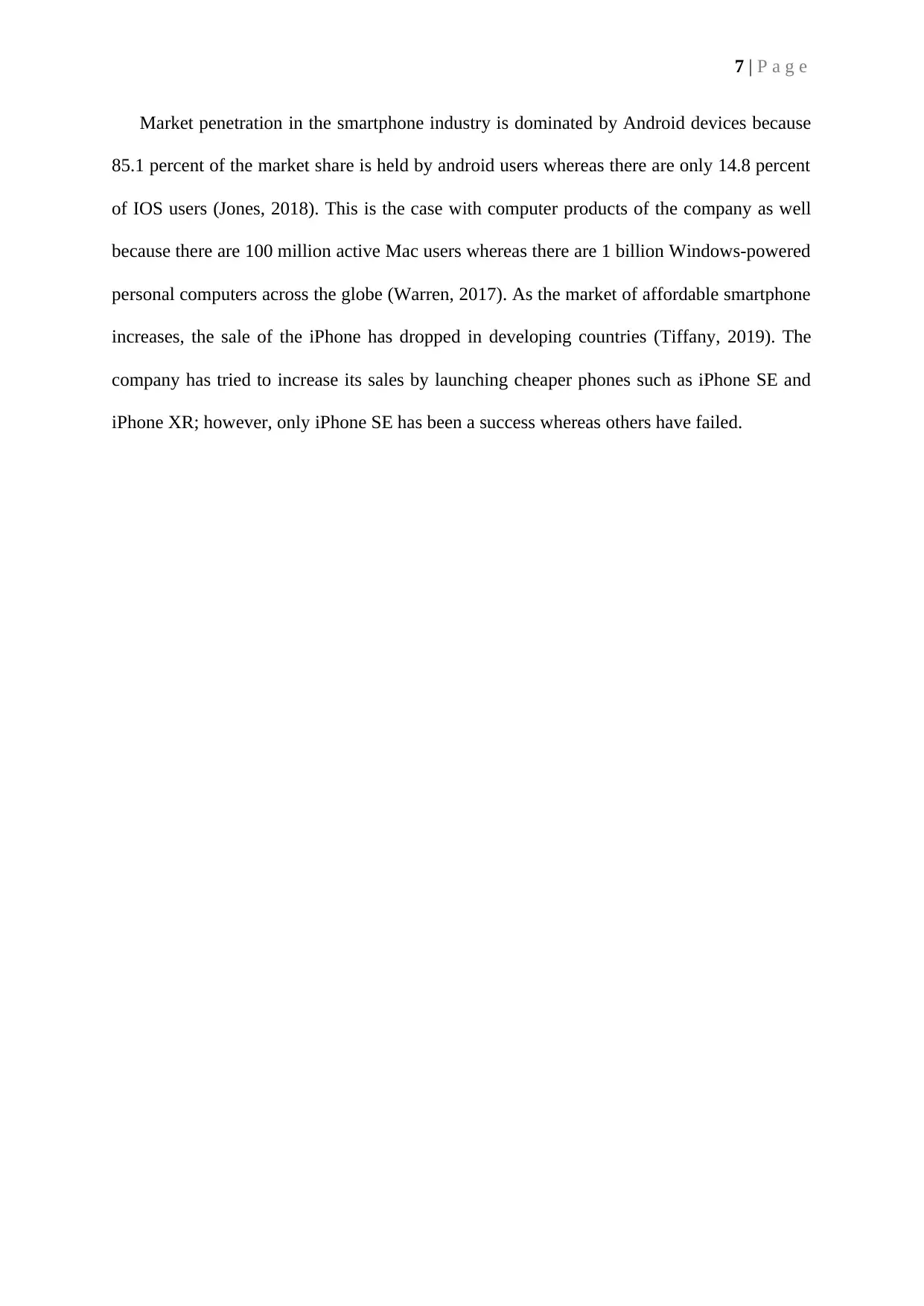
7 | P a g e
Market penetration in the smartphone industry is dominated by Android devices because
85.1 percent of the market share is held by android users whereas there are only 14.8 percent
of IOS users (Jones, 2018). This is the case with computer products of the company as well
because there are 100 million active Mac users whereas there are 1 billion Windows-powered
personal computers across the globe (Warren, 2017). As the market of affordable smartphone
increases, the sale of the iPhone has dropped in developing countries (Tiffany, 2019). The
company has tried to increase its sales by launching cheaper phones such as iPhone SE and
iPhone XR; however, only iPhone SE has been a success whereas others have failed.
Market penetration in the smartphone industry is dominated by Android devices because
85.1 percent of the market share is held by android users whereas there are only 14.8 percent
of IOS users (Jones, 2018). This is the case with computer products of the company as well
because there are 100 million active Mac users whereas there are 1 billion Windows-powered
personal computers across the globe (Warren, 2017). As the market of affordable smartphone
increases, the sale of the iPhone has dropped in developing countries (Tiffany, 2019). The
company has tried to increase its sales by launching cheaper phones such as iPhone SE and
iPhone XR; however, only iPhone SE has been a success whereas others have failed.
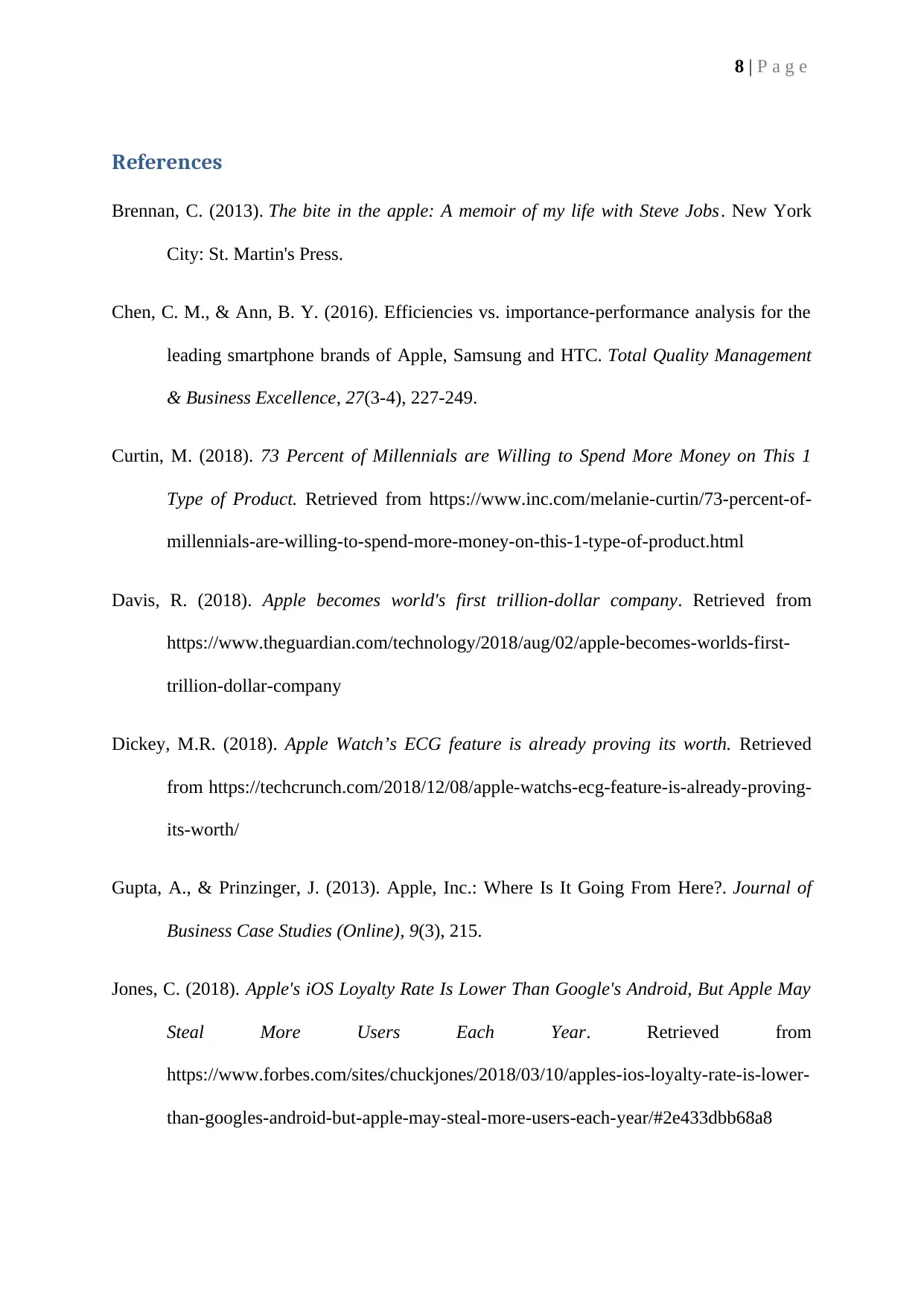
8 | P a g e
References
Brennan, C. (2013). The bite in the apple: A memoir of my life with Steve Jobs. New York
City: St. Martin's Press.
Chen, C. M., & Ann, B. Y. (2016). Efficiencies vs. importance-performance analysis for the
leading smartphone brands of Apple, Samsung and HTC. Total Quality Management
& Business Excellence, 27(3-4), 227-249.
Curtin, M. (2018). 73 Percent of Millennials are Willing to Spend More Money on This 1
Type of Product. Retrieved from https://www.inc.com/melanie-curtin/73-percent-of-
millennials-are-willing-to-spend-more-money-on-this-1-type-of-product.html
Davis, R. (2018). Apple becomes world's first trillion-dollar company. Retrieved from
https://www.theguardian.com/technology/2018/aug/02/apple-becomes-worlds-first-
trillion-dollar-company
Dickey, M.R. (2018). Apple Watch’s ECG feature is already proving its worth. Retrieved
from https://techcrunch.com/2018/12/08/apple-watchs-ecg-feature-is-already-proving-
its-worth/
Gupta, A., & Prinzinger, J. (2013). Apple, Inc.: Where Is It Going From Here?. Journal of
Business Case Studies (Online), 9(3), 215.
Jones, C. (2018). Apple's iOS Loyalty Rate Is Lower Than Google's Android, But Apple May
Steal More Users Each Year. Retrieved from
https://www.forbes.com/sites/chuckjones/2018/03/10/apples-ios-loyalty-rate-is-lower-
than-googles-android-but-apple-may-steal-more-users-each-year/#2e433dbb68a8
References
Brennan, C. (2013). The bite in the apple: A memoir of my life with Steve Jobs. New York
City: St. Martin's Press.
Chen, C. M., & Ann, B. Y. (2016). Efficiencies vs. importance-performance analysis for the
leading smartphone brands of Apple, Samsung and HTC. Total Quality Management
& Business Excellence, 27(3-4), 227-249.
Curtin, M. (2018). 73 Percent of Millennials are Willing to Spend More Money on This 1
Type of Product. Retrieved from https://www.inc.com/melanie-curtin/73-percent-of-
millennials-are-willing-to-spend-more-money-on-this-1-type-of-product.html
Davis, R. (2018). Apple becomes world's first trillion-dollar company. Retrieved from
https://www.theguardian.com/technology/2018/aug/02/apple-becomes-worlds-first-
trillion-dollar-company
Dickey, M.R. (2018). Apple Watch’s ECG feature is already proving its worth. Retrieved
from https://techcrunch.com/2018/12/08/apple-watchs-ecg-feature-is-already-proving-
its-worth/
Gupta, A., & Prinzinger, J. (2013). Apple, Inc.: Where Is It Going From Here?. Journal of
Business Case Studies (Online), 9(3), 215.
Jones, C. (2018). Apple's iOS Loyalty Rate Is Lower Than Google's Android, But Apple May
Steal More Users Each Year. Retrieved from
https://www.forbes.com/sites/chuckjones/2018/03/10/apples-ios-loyalty-rate-is-lower-
than-googles-android-but-apple-may-steal-more-users-each-year/#2e433dbb68a8
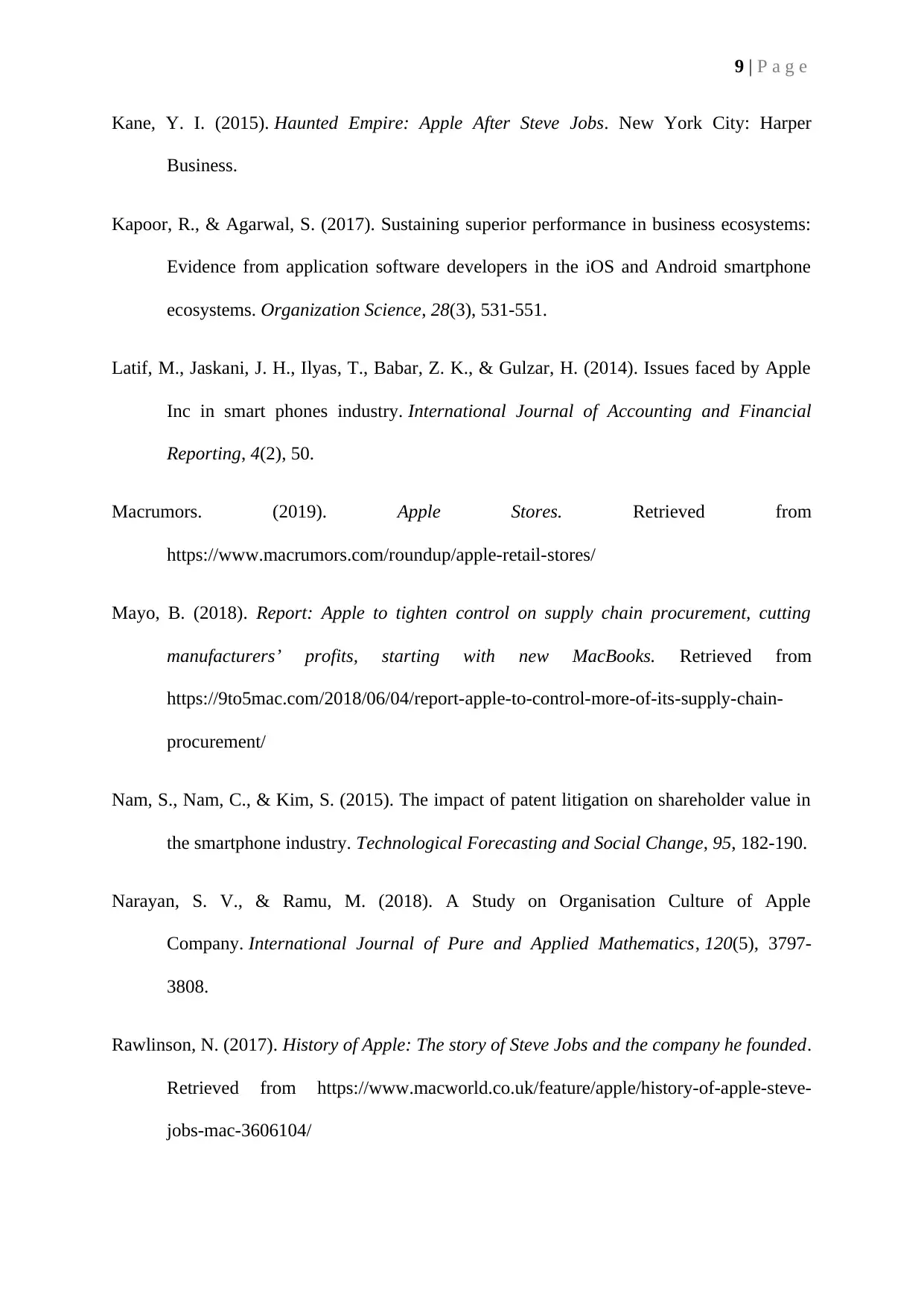
9 | P a g e
Kane, Y. I. (2015). Haunted Empire: Apple After Steve Jobs. New York City: Harper
Business.
Kapoor, R., & Agarwal, S. (2017). Sustaining superior performance in business ecosystems:
Evidence from application software developers in the iOS and Android smartphone
ecosystems. Organization Science, 28(3), 531-551.
Latif, M., Jaskani, J. H., Ilyas, T., Babar, Z. K., & Gulzar, H. (2014). Issues faced by Apple
Inc in smart phones industry. International Journal of Accounting and Financial
Reporting, 4(2), 50.
Macrumors. (2019). Apple Stores. Retrieved from
https://www.macrumors.com/roundup/apple-retail-stores/
Mayo, B. (2018). Report: Apple to tighten control on supply chain procurement, cutting
manufacturers’ profits, starting with new MacBooks. Retrieved from
https://9to5mac.com/2018/06/04/report-apple-to-control-more-of-its-supply-chain-
procurement/
Nam, S., Nam, C., & Kim, S. (2015). The impact of patent litigation on shareholder value in
the smartphone industry. Technological Forecasting and Social Change, 95, 182-190.
Narayan, S. V., & Ramu, M. (2018). A Study on Organisation Culture of Apple
Company. International Journal of Pure and Applied Mathematics, 120(5), 3797-
3808.
Rawlinson, N. (2017). History of Apple: The story of Steve Jobs and the company he founded.
Retrieved from https://www.macworld.co.uk/feature/apple/history-of-apple-steve-
jobs-mac-3606104/
Kane, Y. I. (2015). Haunted Empire: Apple After Steve Jobs. New York City: Harper
Business.
Kapoor, R., & Agarwal, S. (2017). Sustaining superior performance in business ecosystems:
Evidence from application software developers in the iOS and Android smartphone
ecosystems. Organization Science, 28(3), 531-551.
Latif, M., Jaskani, J. H., Ilyas, T., Babar, Z. K., & Gulzar, H. (2014). Issues faced by Apple
Inc in smart phones industry. International Journal of Accounting and Financial
Reporting, 4(2), 50.
Macrumors. (2019). Apple Stores. Retrieved from
https://www.macrumors.com/roundup/apple-retail-stores/
Mayo, B. (2018). Report: Apple to tighten control on supply chain procurement, cutting
manufacturers’ profits, starting with new MacBooks. Retrieved from
https://9to5mac.com/2018/06/04/report-apple-to-control-more-of-its-supply-chain-
procurement/
Nam, S., Nam, C., & Kim, S. (2015). The impact of patent litigation on shareholder value in
the smartphone industry. Technological Forecasting and Social Change, 95, 182-190.
Narayan, S. V., & Ramu, M. (2018). A Study on Organisation Culture of Apple
Company. International Journal of Pure and Applied Mathematics, 120(5), 3797-
3808.
Rawlinson, N. (2017). History of Apple: The story of Steve Jobs and the company he founded.
Retrieved from https://www.macworld.co.uk/feature/apple/history-of-apple-steve-
jobs-mac-3606104/
Secure Best Marks with AI Grader
Need help grading? Try our AI Grader for instant feedback on your assignments.
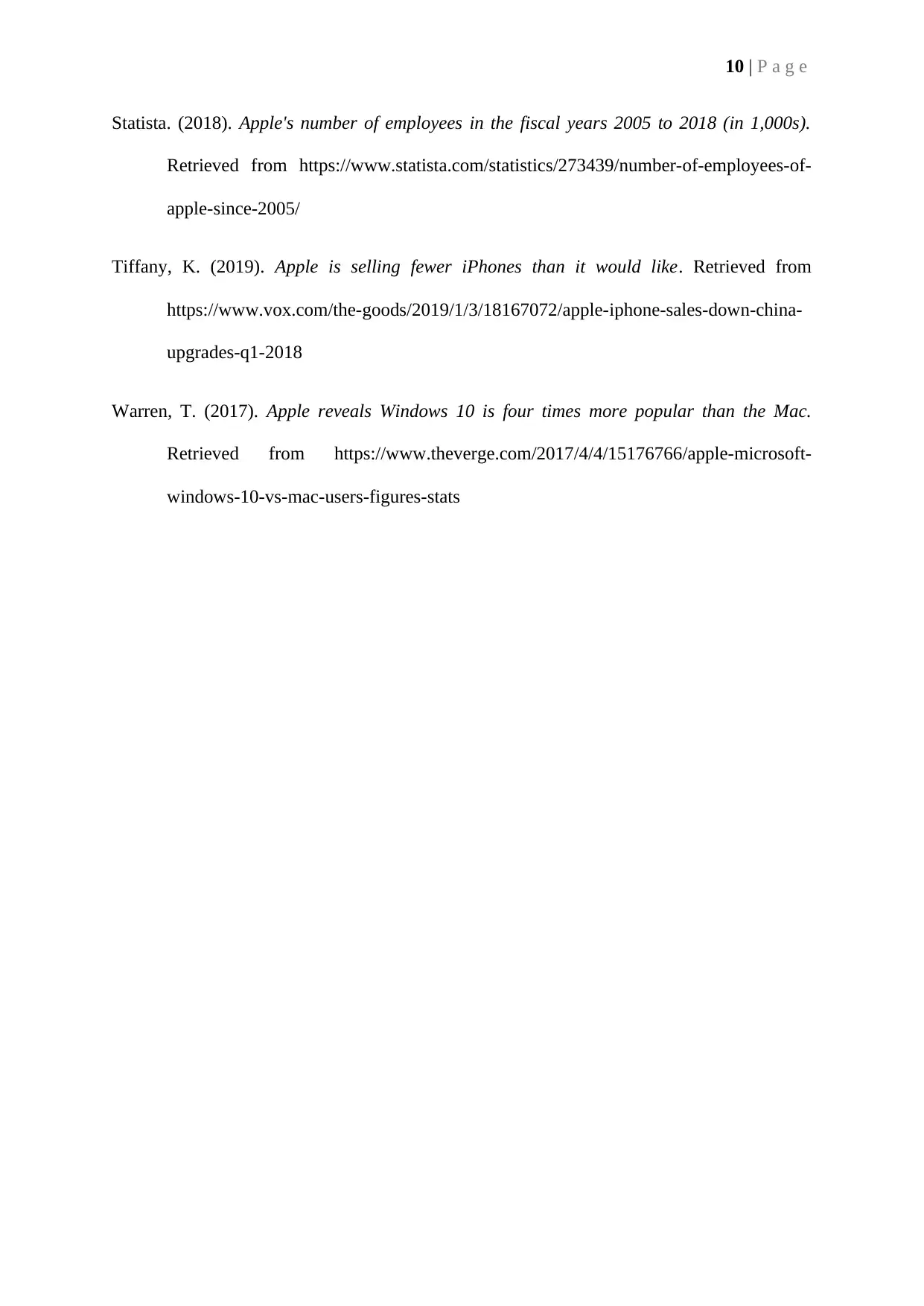
10 | P a g e
Statista. (2018). Apple's number of employees in the fiscal years 2005 to 2018 (in 1,000s).
Retrieved from https://www.statista.com/statistics/273439/number-of-employees-of-
apple-since-2005/
Tiffany, K. (2019). Apple is selling fewer iPhones than it would like. Retrieved from
https://www.vox.com/the-goods/2019/1/3/18167072/apple-iphone-sales-down-china-
upgrades-q1-2018
Warren, T. (2017). Apple reveals Windows 10 is four times more popular than the Mac.
Retrieved from https://www.theverge.com/2017/4/4/15176766/apple-microsoft-
windows-10-vs-mac-users-figures-stats
Statista. (2018). Apple's number of employees in the fiscal years 2005 to 2018 (in 1,000s).
Retrieved from https://www.statista.com/statistics/273439/number-of-employees-of-
apple-since-2005/
Tiffany, K. (2019). Apple is selling fewer iPhones than it would like. Retrieved from
https://www.vox.com/the-goods/2019/1/3/18167072/apple-iphone-sales-down-china-
upgrades-q1-2018
Warren, T. (2017). Apple reveals Windows 10 is four times more popular than the Mac.
Retrieved from https://www.theverge.com/2017/4/4/15176766/apple-microsoft-
windows-10-vs-mac-users-figures-stats
1 out of 11
Related Documents
Your All-in-One AI-Powered Toolkit for Academic Success.
+13062052269
info@desklib.com
Available 24*7 on WhatsApp / Email
![[object Object]](/_next/static/media/star-bottom.7253800d.svg)
Unlock your academic potential
© 2024 | Zucol Services PVT LTD | All rights reserved.





